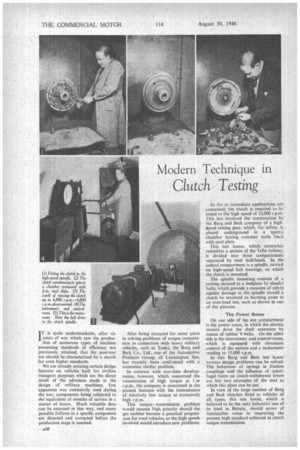Modern Technique in
Page 40

If you've noticed an error in this article please click here to report it so we can fix it.
Clutch Testing
IT is quite understandable, after six years of war -which saw the production of numerous types of machine possessing standards of efficiency not previously attained, that the post-war era should be characterized by a search for even higher standards.
We are already noticing certain design features on vehicles built for civilian transport purposes which are the direct result of the advances made in the design of military machines. Test apparatus was extensively used during the war, components being subjected to the equivalent of months of service in a matter of hours. Much valuable data can be amassed in this way, and many possible failures in a specific component arc detected and corrected before the production stage is reached.
After being occupied for sonic years in solving problems of torque transmission in connection with heavy military vehicles, such as Tanks, the Borg and Beck Co., Ltd., one of the Automotive Products Group, of Leamington Spa, has recently been confronted with a somewhat similar problem.
In contrast with war-time developments, however, which concerned the transmission of high torque at I Av r.p.m., the company is concerned in the present instance with the transmission of relatively low torque at excessively high r.p.m.
This torque transmission problem would assume high priority should the gas turbine become a practical proposition for road vehicles, as the high speeds involved would introduce new problems. So far as immediate applications are concerned, the clutch is required to be tested to the high speed of 12,000 r.p.m. This has involved the construction by the Borg and Beck company of a high/peed testing gear, which, for safety, is placed underground in a speck.' chamber having concrete walls lined with steel plate.
This test house, which somewhat resembles a section of the Tube railway, is divided into three compartments separated by steel bulkheads. In the central compartment is a spindle, carried on high-speed ball bearings; on which the clutch is mounted.
The spindle mounting consists of a casting secured to a bedplate by slendcr bolts, which provide a measure of safety against damage to the spindle should a clutch be revolved to bursting point in an over-load test, such as shown in one of the pictures.
The Power Room
On one side of the test compartment is the power room, in which the electric motors drive the shaft extension by means of rubber V-belts. On the other side is the instrumentand control-room, which is equipped with rheostatic control of the motors and a tachometer reading to 15,000 r.p.m.
In this Borg and Beck test house various design problems can be solved. The behaviour of springs in friction couplings and the influence of centrifugal force on clutch-withdrawal levers are but two examples of the uses to which this plant can be put.
In view of the large number of Borg and Beck clutches fitted to vehicles of all types, this test house, which is believed to be the only industrial one of its kind in Britain, should prove of inestimable value in improving the present high standard achieved in clutch torque transmission.




































































